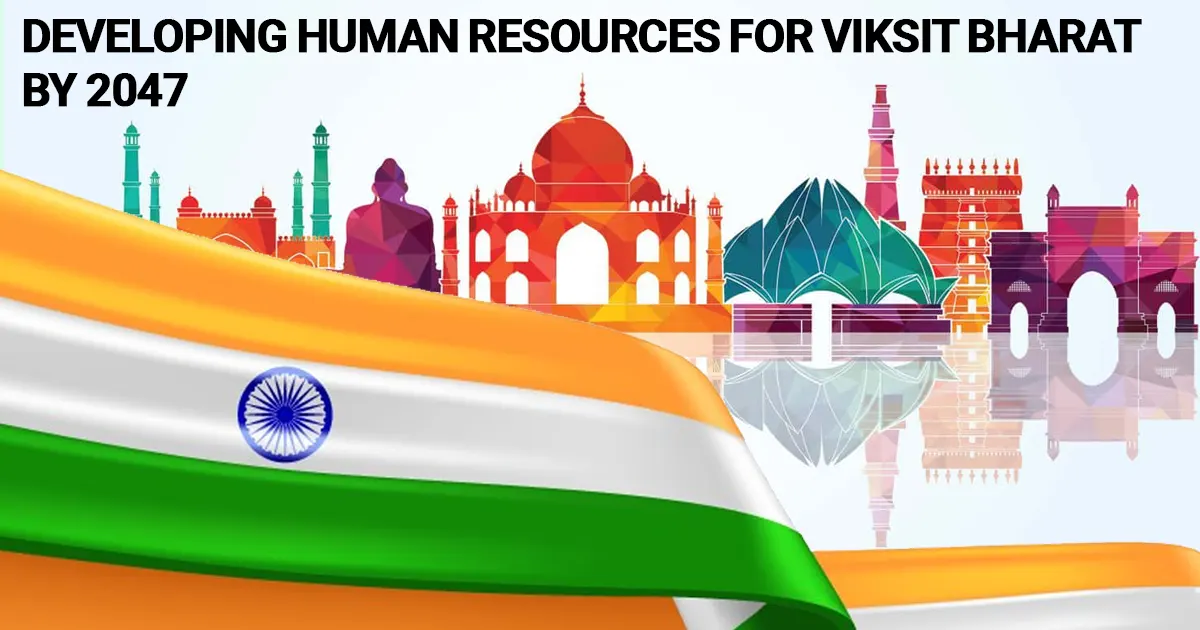GS-2-Governance

Context:
‘Viksit Bharat’ envisions transforming India into a $30-trillion developed economy by 2047, the 100th year of independence. To realize this goal, it is essential to empower and enhance the capabilities of key groups: youth (Yuva), poor (Garib), women (Mahila), and farmers (Kisan).
Challenges in Attaining Viksit Bharat
- Education and Skill Development:
- Current government spending on education stands at over 4% of GDP, yet practical skills and problem-solving remain underemphasized.
- Limited alignment of educational outcomes with market demands.
- Health Infrastructure:
- Public health expenditure is just 2.1% of GDP, insufficient to ensure robust healthcare systems.
- Demographic Shifts:
- By 2047, both younger and older working-age groups will each constitute 28% of the population, necessitating policies to balance workforce dynamics.
- Human Development Deficit:
- India ranks 134th on the UN Human Development Index (HDI), indicating gaps in health, education, and income parameters.
- Unemployment:
- Youth unemployment, although reduced to 18.4% in 2022, still constitutes 82.9% of total unemployment.
- The recent India Employment Report (2024) highlights unsatisfactory job creation outcomes.
- Gender Gap:
- Female labor force participation (32.8% in 2022) is among the lowest globally, significantly lagging behind male participation (77.2%).
- Sustained Growth Requirement:
- To achieve a $30-trillion economy, India must maintain an annual growth rate of 8% for the next two decades—a challenging target requiring inclusive and uniform growth.
Measures to Attain Viksit Bharat by 2047
- Education and Skill Development:
- Expand investment in skill training to boost employability.
- Initiatives: Ministry of Skill Development and Entrepreneurship (MSDE), Pradhan Mantri Kaushal Vikas Yojana (PMKVY), Jan Shikshan Sansthan (JSS), National Apprenticeship Promotion Scheme (NAPS), and Industrial Training Institutes (ITIs).
- Health and Well-being:
- Strengthen affordable healthcare infrastructure.
- Initiatives: Ayushman Bharat Health Infrastructure Mission (PM-ABHIM), Ayushman Bharat Pradhan Mantri Jan Arogya Yojana (AB PM-JAY), and Pradhan Mantri Swasthya Suraksha Yojana (PMSSY).
- Combat Malnutrition:
- Address high rates of stunting, wasting, and anemia among children.
- Initiatives: Integrated Child Development Scheme (ICDS), Poshan Abhiyaan, Anaemia-mukt Bharat, and Mission Indradhanush.
- Promote Research, Innovation, and Technology Adoption:
- Invest in research, enhance academia-industry collaborations, and encourage innovation.
- Initiatives: National Research Foundation by ISRO, Atal Innovation Mission.
- Bridge the Digital Divide:
- Digital inclusivity is critical for a data-driven economy.
- Initiatives: Digital Bus Project in Maharashtra, digital literacy programs.
- Strengthen Agriculture:
- Agriculture remains pivotal, engaging 45% of the workforce.
- Initiatives: Pradhan Mantri Krishi Sinchayee Yojana (PMKSY), National Agriculture Market (e-NAM), Pradhan Mantri Fasal Bima Yojana (PMFBY).
Conclusion:
Achieving the vision of Viksit Bharat by 2047 demands a focus on five critical policy areas:
- Job Creation: Encourage industries and entrepreneurship to generate employment.
- Quality of Employment: Enhance job security, wages, and working conditions.
- Labor Market Equity: Reduce gender disparities and promote inclusivity.
- Skill Development: Strengthen active labor market policies to adapt to emerging trends.
- Knowledge Enhancement: Bridge research gaps in labor markets and youth employment.
With sustained efforts, India can turn its vast human resources into a key driver of development, propelling the nation towards its vision of becoming a $30-trillion economy by 2047.
[box] “Critically analyze the key challenges India faces in achieving the vision of ‘Viksit Bharat’ by 2047. Suggest measures to address these challenges, focusing on education, health, employment, and gender equity.”
[button color=”purple ” size=”medium” link=”https://forms.gle/Wzz7M6oVE4bQS8Ws8″ icon=”” target=”true”]Upload Answer[/button]
[/box]




